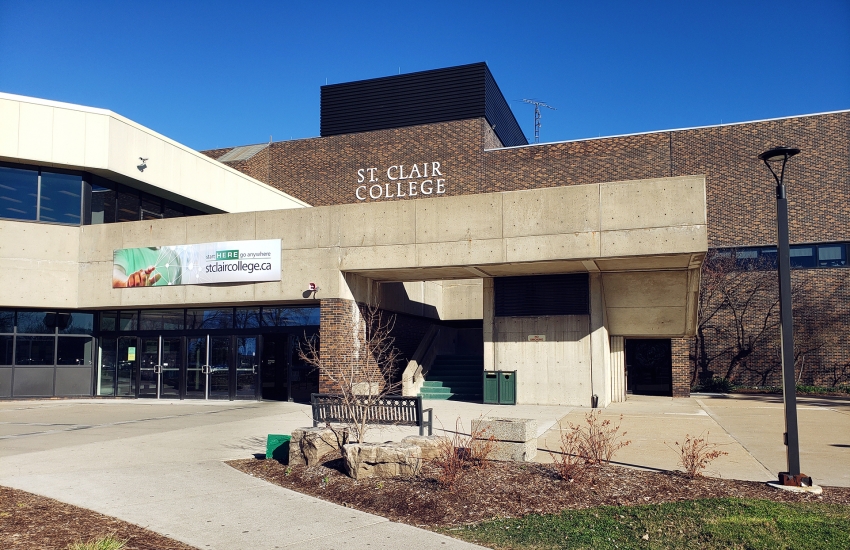
An unprecedented $40 million surplus in the 2018-2019 budget will allow St. Clair College to spend some money on capital improvements and program enhancements, the Board of Governors was told at its final meeting of the year.
The 2018-2019 budget, which was approved by the Board of Governors last spring, had projected revenues of $182.7 million and expenditures of $172.2 million, for a projected surplus of about $10.5 million.
The actual figures at the end of the college’s fiscal year March 31, 2019, showed revenues of $198.3 million, versus expenditures of $158 million, resulting in the $40 million surplus.
Chief Financial Officer Marc Jones detailed the causes of the higher revenues and lower expenditures in his report to the Board of Governors, while President Patti France and Governor/Audit Committee Chair Egidio Sovran discussed what should be done with the newfound surplus.
Reflecting on the dire circumstances the college found itself in just five years ago, when it was saddled with a deficit, France noted, “If you have money, you have choices” – to invest in existing and new academic programming, make equipment upgrades, to renovate and develop facilities. “If you don’t have money, you don’t have those choices.”
The size of this surplus allows this year’s Board of Governors to extend that flexibility to those that follow it, France said. While some of the cash could be injected into the 2019-20 revenue stream to carry out some current-year projects, “holding some (portion of the surplus) in reserves (a ‘piggy bank’ of short- and long-term investments) means that future boards and presidents will have choices”, even if they are occasionally confronted with economic downturns.
Sovran said the Audit Committee had directed Jones to develop some recommendations about specific uses of the surplus, including how much should be placed into reserves. The CFO will provide those recommendations to the Board of Governors when it resumes its regular meeting schedule in September.
Budget Highlights:
REVENUES
- Provincial Ministry of Training, Colleges and Universities (MTCU) Operating Grants are higher than budget at $2,520,881 or 5.4 percent due to an increase in “Other MTCU” funding of $2,463,989.
- Total Tuition revenue is higher than the budget at $8,272,173 or 9.6 percent because of increases in international postsecondary tuition revenue totalling $6,901,688, and student withdrawals and dismissals being lower than projected. A major factor of that hike in global revenue, France noted, was the college’s addition of a spring/summer semester for a dozen or so popular programs. There was also an increase in domestic postsecondary tuition revenue of $1,620,836 due to student withdrawals and dismissals being lower than projected.
- Total “Other” income is higher than the budget at $3,699,979 or 14.3 percent. When fiscal year-end accounting adjustments related to the Foundation ($544,345), Bursaries and Scholarships ($303,734) and Capital Support Grants ($152,954) are removed, the resulting “Other” income is higher than budget at $2,698,946 or 10.4 percent due to the following:
- Increase in International Project revenue of $1,091,522 due to higher application and administrative fees from increased international enrolment;
- Increase in International Insurance revenue of $505,706 due to increased international enrolment;
- Increase in investment income of $393,794 due to excess cash being invested;
- Increase in revenue of $396,587 from Research & Development grant funding.
EXPENDITURES
- Total Salaries & Benefits are lower than budget at $7,432,245 or 7.9 percent due to the following:
- Decrease in Full-Time Faculty and Support due to unplanned retirements, delayed hiring, and lower overtime;
- Decrease in Part-Time Faculty due to increased section sizes, actual teaching hours lower than budget, and actual hourly rates being under budget;
- Decrease in Fringe Benefits of $1,772,185 as a result of the overall lower Salaries and Benefits costs.
- Total Non-Salary expenditures are higher than budget at $6,970,393 or 10 percent. When fiscal year-end accounting adjustments related to the Foundation ($544,345), Bursaries and Scholarships ($302,737), and Capital Support Grants ($152,954) are removed, the resulting Non-Salary expenditure is higher than budget at $5,970,357 or 8.6 percent due to the following:
- Decrease in Contracted Services Other due to agent commissions;
- Decrease in Insurance expense due to health and dental benefits for international students;
- Decrease in “Other” expenses due to bad debt expense related to student receivables;
- Decrease in Utilities due to energy conservation improvements made to facilities;
- Decrease in discretionary spending across contracted educational services, equipment repairs and maintenance, instructional supplies, janitorial supplies, office supplies, and travel.
This conservative approach to expenditure management allowed Administration to be flexible and adjust resources where required.
ANCILLARY OPERATIONS
Total Ancillary operations surplus is higher than budget at $1,084,206 due to the following:
- Increase in Parking Lot surplus of $398,914 due to increased parking fees and a change in permit sales from annual parking to per semester parking;
- Increase in Residence surplus of $475,644 due to lower operating expenses and increased capacity over the summer months;
- Increase in St. Clair College Centre for the Arts surplus of $251,460 due to higher banquet revenue.